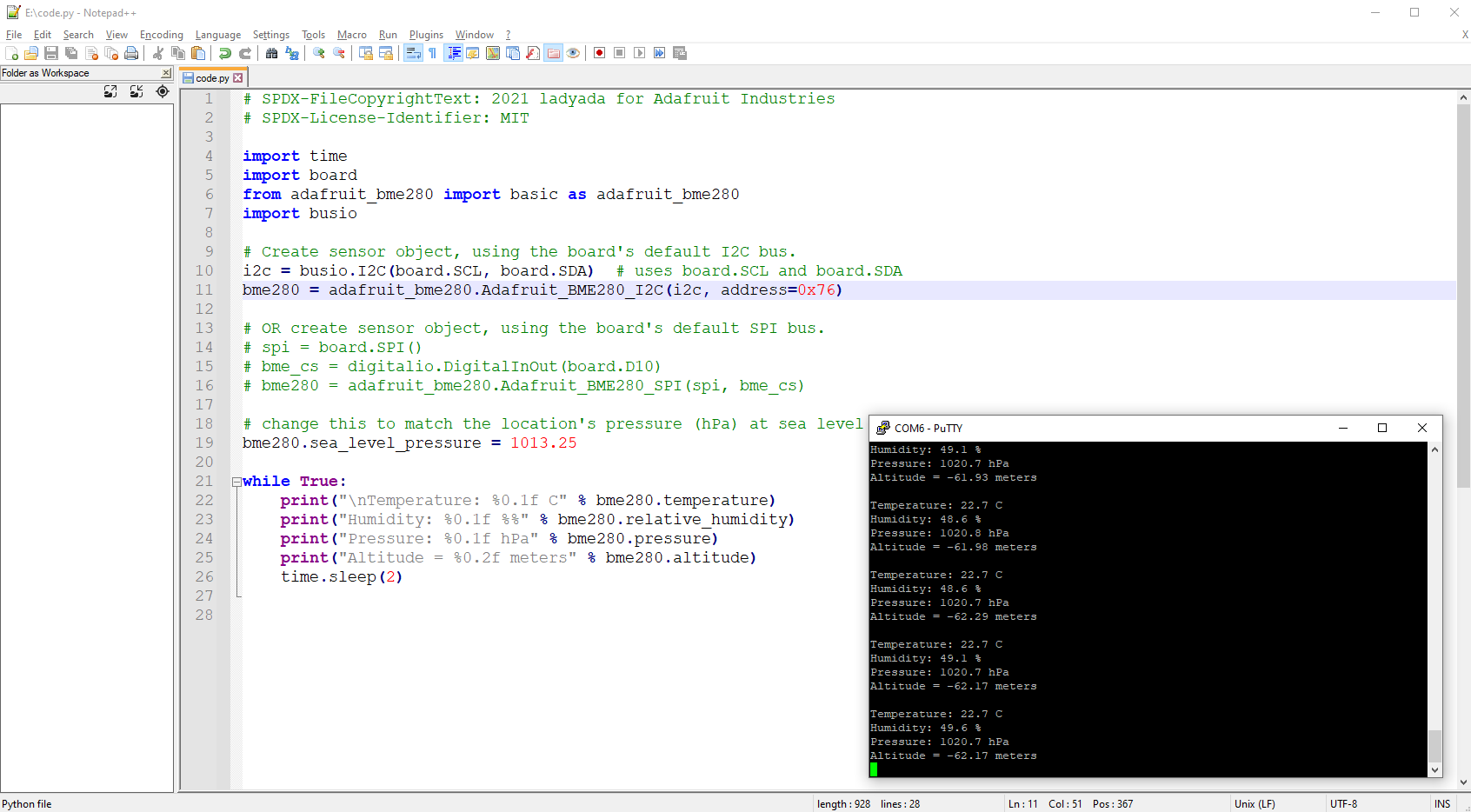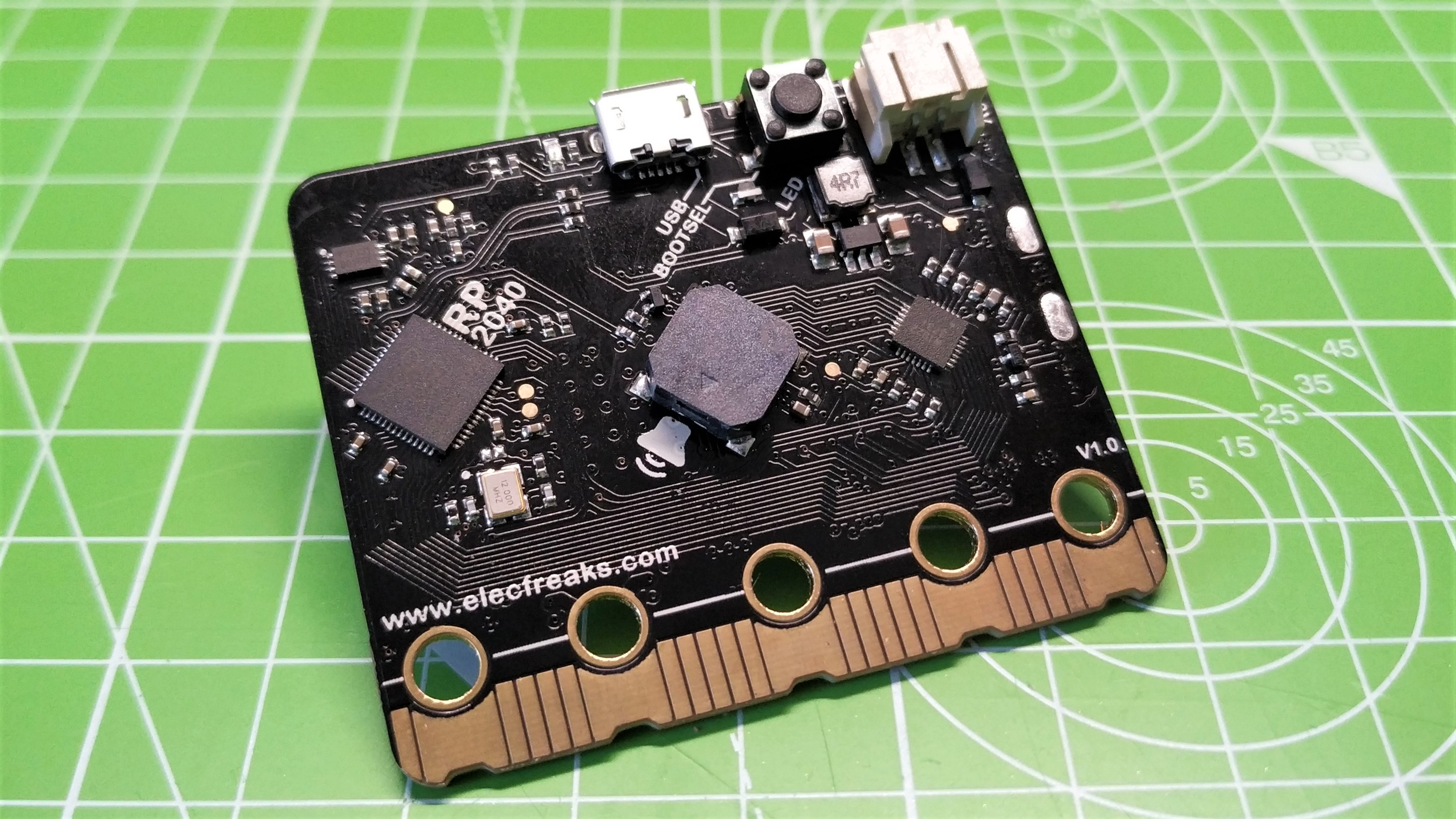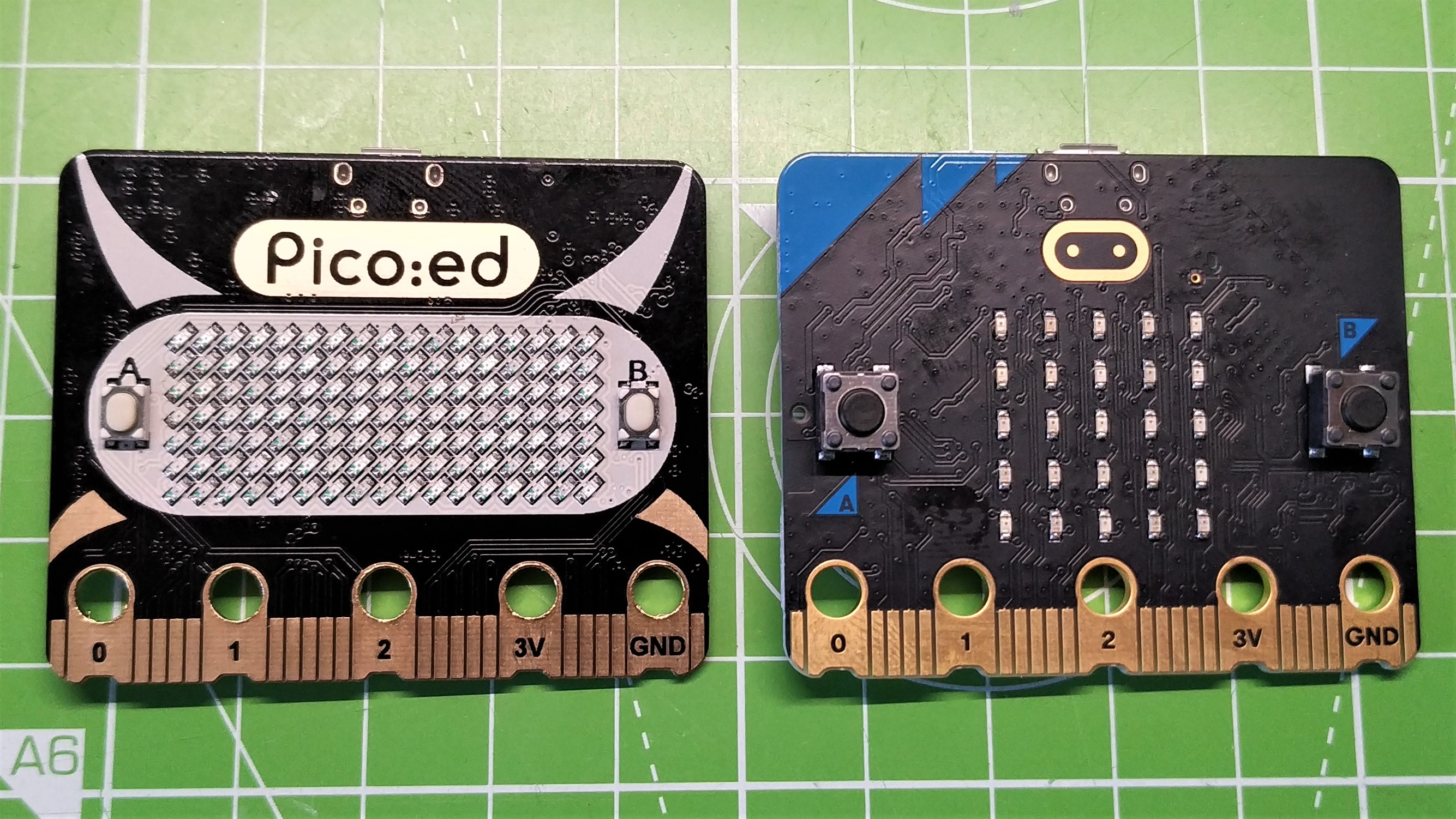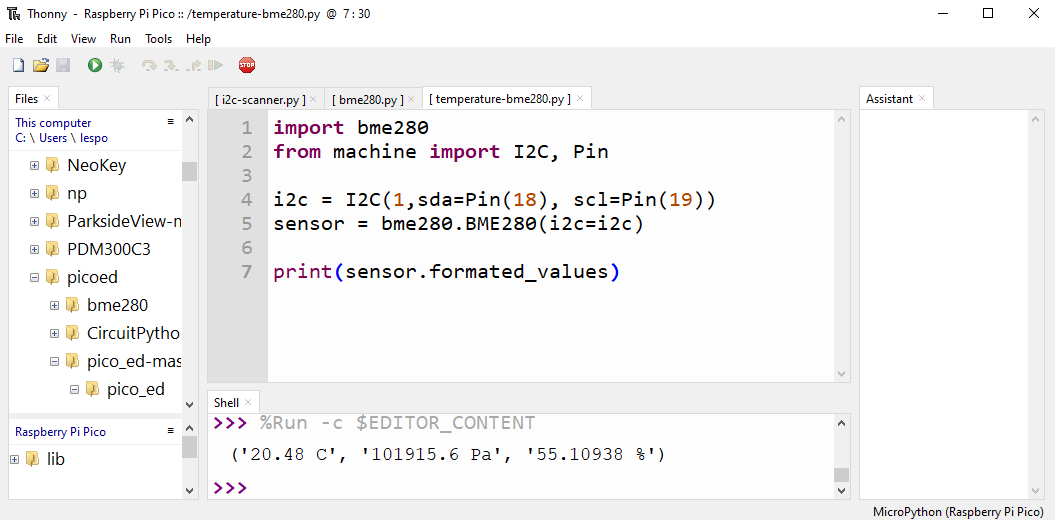Elecfreaks Pico:ed Review: RP2040 in a Micro:Bit Form Factor
They say that imitation is the sincerest form of flattery, so it seems that Elecfreaks latest board, the Pico:ed, is a homage to the micro:bit range of boards. Pico:ed features the Raspberry Pi RP2040 SoC in a more educational form factor, and the $13 price tag is certainly enticing for those wishing to start their coding journey.
Pico:ed shares the same form factor as the micro:bit, and at a glance it looks like a distant cousin. Instead of a 5×5 LED matrix, Pico:ed has a rather odd 7×17 matrix and two simple button inputs. At the bottom of the board are a series of GPIO “pins”, broken out to an edge connector that looks like a set of gold teeth. Some of the pins can be used with crocodile clips, which are very useful for educational environments where soldering and working with small pins and jumpers isn’t always practical.
Is the Pico:ed destined for the makerspace or the classroom? To find out we need to get to know this fun looking board.
Pico:ed Hardware Specifications
| Elecfreaks Pico:ed | micro:bit v2 | |
|---|---|---|
| System on Chip (SoC) | RP2040 microcontroller | Nordic Semiconductor nRF52833 |
| Dual-core Arm Cortex M0+ processor, flexible clock running up to 133 MHz. | ||
| RAM | 264KB of SRAM | 128KB |
| Storage | 2MB Flash storage | 512Kb |
| GPIO | 19 Pins via edge connector | 25 Pins via edge connector |
| 4 x Analog Inputs | 5 x Analog inputs | |
| 3 x GPIO via crocodile clip connections | 3 x GPIO via crocodile clip connections | |
| 2 x I2C | 1 x I2C | |
| 2 x SPI | 2 x SPI | |
| 1 x UART | 1 x UART | |
| Inputs / Outputs | 2 x Push buttons | 2 x Push buttons |
| 7 x 17 Single color LED matrix | Mems microphone | |
| Buzzer | 5 x 5 single color LED matrix | |
| Buzzer | ||
| Accelerometer | ||
| Magnetometer | ||
| Radio connectivity | ||
| Bluetooth Low Energy | ||
| Power | Micro USB or 3V AA battery pack | Micro USB or 3V AA battery pack |
| Dimensions | 52 x 42mm | 50 x 40mm |
| Programming Languages | MicroPython | MicroPython |
| CircuitPython | CircuitPython | |
| C++ | C++ | |
| MakeCode | ||
| Scratch | ||
| Price | $13 | $20 |
Using Pico:ed
Let’s get one thing straight: we love the form factor. Heavily inspired by the micro:bit project, Pico:ed can be used in two ways. The first way is to attach crocodile clip connectors for pins 0,1,2 and for 3V and GND. For younger makers looking to dip their toe into electronics, those are an exceptionally accessible way to build basic projects.
The second way is to employ the edge connector which breaks out 19 GPIO pins for use in breadboards and with specialist boards. These two approaches enable Pico:ed (and micro:bit) to grow with the user’s abilities.
Pico:ed is a typical RP2040 based board and that means we can use MicroPython, C++ and CircuitPython. The Elecfreaks website has examples, but it seems to focus more on MicroPython than other languages.
We took Pico:ed for a test drive using its own MicroPython library which abstracts button presses, control of the LED matrix and basic control of the onboard buzzer. The MicroPython library is easy to use, a little rough around the edges but perfectly serviceable. Within a short while we were able to scroll messages across the LED matrix, play music using the buzzer and react to user input. But that is it, there are no extra sensors on the board.
The micro:bit features a magnetometer, accelerometer, microphone (v2) and a radio chip with Bluetooth. The micro:bit v2 does retail for $20, versus the $13 of the Pico:ed, but we can’t help but think that spending a little more grants a lot more learning opportunities.
The Pico:ed’s lack of wireless connectivity is a big downer. The micro:bit has an excellent short range radio and Bluetooth Low Energy (BLE) connectivity which means that multiple boards can talk to each other. We would happily pay $7 more for this feature.
The form factor lends itself to micro:bit accessories and luckily we have lots of them so we tried a few out. The first was Proto-Pic’s micro:pixel, a delightful 4 x 8 NeoPixel matrix that produces bright, vibrant swathes of light. Well it should have. Sadly Pico:ed just didn’t want to work with the micro:pixel add-on. Each time we connected it, Pico:ed would fail to be detected by our test machine. We removed micro:pixel and reconnected Pico:ed to our PC and everything was normal.
The same thing happened when we tested two Kitronik motor driver boards. We had success with Pimoroni’s Pinbetween, a breakout board to use all of the GPIO pins with standard breadboards and throughhole electronic components.
Our greatest success was with Pimoroni’s enviro:bit which provides a BME280 temperature / humidity / air pressure sensor, color and light sensor and a microphone. We managed to get reliable data from the BME280 using a third-party MicroPython library and by confirming the pinout of the enviro:bit and translating that to the Pico:ed pinout. That was a bit of a head-scratcher, but we got there in the end.

We installed the latest version of CircuitPython and we had access to the GPIO, making NeoPixels light up and giving us basic pin control. We tried to recreate the BME280 / enviro:bit experiment but we hit a snag. CircuitPython names the second I2C connection as SDA and SCL, with no mention of I2C0_SDA or I2C0_SCL to identify which of the two connections it is. After managing to connect to the sensor, the next hurdle was identifying the BME280’s I2C address. Luckily Pimoroni has this documented and we were able to add the address to our code and get live temperature data.
The short answer is that Pico:ed is a compromise when it comes to accessories and programming languages. Some accessories will work, some need tweaking, but there will be some that will never work.
Who is Pico:ed for?

The form factor lends itself to educational use. If you are looking to use the RP2040 in the classroom then Pico:ed is a decent option, but at 3 times the cost of a Pico you aren’t getting much value for your money. Educators will love its ease of use, and instant results thanks to the MicroPython library. Makers will yearn for more features.
Bottom Line

Pico:ed is a great form factor and an interesting product but it isn’t an RP2040 for all. Educators will enjoy this board, hence the “ed” for education. But for just a few dollars more we can get the micro:bit v2 which has more sensors, radio and full compatibility with micro:bit add-ons.
Makers wanting the power (and availability) of the RP2040 will need to look elsewhere. The $4 Raspberry Pi Pico is the development board standard and it is hard to fault given its price and availability. If we need special features, then there are a plethora of alternatives, most of which are on our list of the best RP2040 boards.
Pico:ed is not a bad product. It is fun to use and you can learn a lot from it, but after that there isn’t much more we can use it for. If you like the form factor and want to play around with the RP2040, go for it. If you want to build with the RP2040, seek out an alternative.
They say that imitation is the sincerest form of flattery, so it seems that Elecfreaks latest board, the Pico:ed, is a homage to the micro:bit range of boards. Pico:ed features the Raspberry Pi RP2040 SoC in a more educational form factor, and the $13 price tag is certainly enticing for those wishing to start their coding journey.
Pico:ed shares the same form factor as the micro:bit, and at a glance it looks like a distant cousin. Instead of a 5×5 LED matrix, Pico:ed has a rather odd 7×17 matrix and two simple button inputs. At the bottom of the board are a series of GPIO “pins”, broken out to an edge connector that looks like a set of gold teeth. Some of the pins can be used with crocodile clips, which are very useful for educational environments where soldering and working with small pins and jumpers isn’t always practical.
Is the Pico:ed destined for the makerspace or the classroom? To find out we need to get to know this fun looking board.
Pico:ed Hardware Specifications
| Elecfreaks Pico:ed | micro:bit v2 | |
|---|---|---|
| System on Chip (SoC) | RP2040 microcontroller | Nordic Semiconductor nRF52833 |
| Dual-core Arm Cortex M0+ processor, flexible clock running up to 133 MHz. | ||
| RAM | 264KB of SRAM | 128KB |
| Storage | 2MB Flash storage | 512Kb |
| GPIO | 19 Pins via edge connector | 25 Pins via edge connector |
| 4 x Analog Inputs | 5 x Analog inputs | |
| 3 x GPIO via crocodile clip connections | 3 x GPIO via crocodile clip connections | |
| 2 x I2C | 1 x I2C | |
| 2 x SPI | 2 x SPI | |
| 1 x UART | 1 x UART | |
| Inputs / Outputs | 2 x Push buttons | 2 x Push buttons |
| 7 x 17 Single color LED matrix | Mems microphone | |
| Buzzer | 5 x 5 single color LED matrix | |
| Buzzer | ||
| Accelerometer | ||
| Magnetometer | ||
| Radio connectivity | ||
| Bluetooth Low Energy | ||
| Power | Micro USB or 3V AA battery pack | Micro USB or 3V AA battery pack |
| Dimensions | 52 x 42mm | 50 x 40mm |
| Programming Languages | MicroPython | MicroPython |
| CircuitPython | CircuitPython | |
| C++ | C++ | |
| MakeCode | ||
| Scratch | ||
| Price | $13 | $20 |
Using Pico:ed
Let’s get one thing straight: we love the form factor. Heavily inspired by the micro:bit project, Pico:ed can be used in two ways. The first way is to attach crocodile clip connectors for pins 0,1,2 and for 3V and GND. For younger makers looking to dip their toe into electronics, those are an exceptionally accessible way to build basic projects.
The second way is to employ the edge connector which breaks out 19 GPIO pins for use in breadboards and with specialist boards. These two approaches enable Pico:ed (and micro:bit) to grow with the user’s abilities.
Pico:ed is a typical RP2040 based board and that means we can use MicroPython, C++ and CircuitPython. The Elecfreaks website has examples, but it seems to focus more on MicroPython than other languages.
We took Pico:ed for a test drive using its own MicroPython library which abstracts button presses, control of the LED matrix and basic control of the onboard buzzer. The MicroPython library is easy to use, a little rough around the edges but perfectly serviceable. Within a short while we were able to scroll messages across the LED matrix, play music using the buzzer and react to user input. But that is it, there are no extra sensors on the board.
The micro:bit features a magnetometer, accelerometer, microphone (v2) and a radio chip with Bluetooth. The micro:bit v2 does retail for $20, versus the $13 of the Pico:ed, but we can’t help but think that spending a little more grants a lot more learning opportunities.
The Pico:ed’s lack of wireless connectivity is a big downer. The micro:bit has an excellent short range radio and Bluetooth Low Energy (BLE) connectivity which means that multiple boards can talk to each other. We would happily pay $7 more for this feature.
The form factor lends itself to micro:bit accessories and luckily we have lots of them so we tried a few out. The first was Proto-Pic’s micro:pixel, a delightful 4 x 8 NeoPixel matrix that produces bright, vibrant swathes of light. Well it should have. Sadly Pico:ed just didn’t want to work with the micro:pixel add-on. Each time we connected it, Pico:ed would fail to be detected by our test machine. We removed micro:pixel and reconnected Pico:ed to our PC and everything was normal.
The same thing happened when we tested two Kitronik motor driver boards. We had success with Pimoroni’s Pinbetween, a breakout board to use all of the GPIO pins with standard breadboards and throughhole electronic components.

Our greatest success was with Pimoroni’s enviro:bit which provides a BME280 temperature / humidity / air pressure sensor, color and light sensor and a microphone. We managed to get reliable data from the BME280 using a third-party MicroPython library and by confirming the pinout of the enviro:bit and translating that to the Pico:ed pinout. That was a bit of a head-scratcher, but we got there in the end.

We installed the latest version of CircuitPython and we had access to the GPIO, making NeoPixels light up and giving us basic pin control. We tried to recreate the BME280 / enviro:bit experiment but we hit a snag. CircuitPython names the second I2C connection as SDA and SCL, with no mention of I2C0_SDA or I2C0_SCL to identify which of the two connections it is. After managing to connect to the sensor, the next hurdle was identifying the BME280’s I2C address. Luckily Pimoroni has this documented and we were able to add the address to our code and get live temperature data.
The short answer is that Pico:ed is a compromise when it comes to accessories and programming languages. Some accessories will work, some need tweaking, but there will be some that will never work.
Who is Pico:ed for?

The form factor lends itself to educational use. If you are looking to use the RP2040 in the classroom then Pico:ed is a decent option, but at 3 times the cost of a Pico you aren’t getting much value for your money. Educators will love its ease of use, and instant results thanks to the MicroPython library. Makers will yearn for more features.
Bottom Line

Pico:ed is a great form factor and an interesting product but it isn’t an RP2040 for all. Educators will enjoy this board, hence the “ed” for education. But for just a few dollars more we can get the micro:bit v2 which has more sensors, radio and full compatibility with micro:bit add-ons.
Makers wanting the power (and availability) of the RP2040 will need to look elsewhere. The $4 Raspberry Pi Pico is the development board standard and it is hard to fault given its price and availability. If we need special features, then there are a plethora of alternatives, most of which are on our list of the best RP2040 boards.
Pico:ed is not a bad product. It is fun to use and you can learn a lot from it, but after that there isn’t much more we can use it for. If you like the form factor and want to play around with the RP2040, go for it. If you want to build with the RP2040, seek out an alternative.
